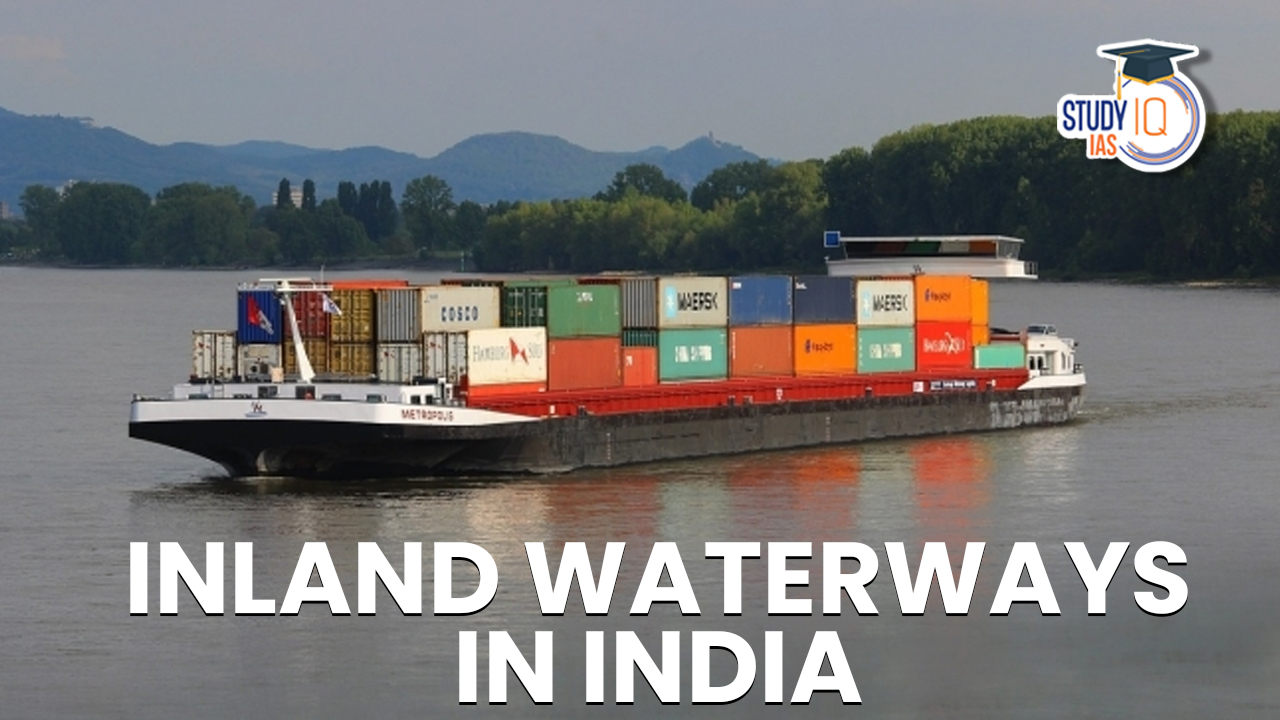Table of Contents
Context: The Parliamentary Standing Committee on Transport, Tourism and Culture has submitted a report on ‘Development and Expansion of Existing and New National Inland Waterways’.
What are Inland Waterways?
- Inland waterways are navigable bodies of water, such as rivers, canals, and lakes, that are used for transportation, trade, and recreation.
- India’s potential: India has about 14,500 km of navigable waterways which comprise of rivers, canals, backwaters, creeks, etc.
- However, inland water transport (IWT) accounts for less than 1% of its freight traffic, compared to 35% in Bangladesh and 20% in Germany.
- Current Status in India:
- There are 111 officially notified Inland National Waterways (NWs) in India identified for the purposes of inland water transport, as per The National Waterways Act, 2016.
- Based on the feasibility reports, 25 NWs have been found viable by Inland Waterways Authority of India (IWAI) for cargo/ passenger movement.
- Development activities have been initiated in the first 13 NWs (see the image below) out of the 25 viable NWs.
Advantages of Inland Water Transport (IWT)
- Cost-effectiveness: IWT is highly cost effective, especially for the transport of bulk goods due to high carrying capacity of inland waterways and requirement of less fuel.
- Fuel efficiency: According to the World Bank, IWT is 28% more fuel-efficient than road transportation and 64% more fuel-efficient than rail transportation.
- Environmental friendliness: IWT produces fewer emissions than road and rail transportation.
- Safety: Fewer accidents on inland waterways than on roads or railways.
- Connectivity: Inland waterways can provide connectivity to remote areas that are not accessible by road or rail. E.g., the North-Eastern Region (NER).
- Development potential: The development of waterways will stimulate industrial growth and tourism.
Concerns associated with the Inland Water Transport (IWT)
- Seasonal Water Level Variations: Seasonal falls in water levels, especially in rain-fed rivers of the peninsula severely affect the feasibility of IWT.
- Water Diversion for Irrigation: Reduced water flow in rivers due to diversion for irrigation purposes, like the case of the Ganga River.
- Navigability Issues: Reduced navigability due to siltation, waterfalls, cataracts in rivers, and salinity in coastal areas can hinder the smooth operation of IWT.
- Delta Channels and Dredging: Many large rivers in India flow into the sea via shallow sand-filled delta channels, requiring frequent dredging to maintain navigability.
- Environmental concerns:
- Effect on river ecology: Dredging operations can damage riverbeds, disrupt aquatic habitats, and affect the ability of water to percolate underground.
- Deforestation: Construction of jetties and river ports may require the removal of trees and mangrove forests, leading to ecosystem disruption.
- Pollution: Vessels in IWT can contribute to pollution through oil and diesel emissions, as well as cargo leakage and spills.
- Social concerns:
- Livelihood Disruption: Effects on river ecology due to IWT can impact fishing communities and riverbed cultivators.
- Displacement: The need for land to build facilities like ports and jetties can result in land displacement and community disruptions.
Key Observations and Recommendations of the Parliamentary Standing Committee
- Operationalization of National Waterways: Out of 111 notified national waterways, only 23 are operational due to financial and staffing constraints.
- Recommendation: The Committee recommended against developing the remaining 63 waterways at this time due to their unviability.
- Constraints for switching to IWT: Five national waterways handle 80% of total cargo movement. The Committee identified factors discouraging companies from shifting to inland waterways, including slow development, poor hinterland connectivity, and high vessel costs.
- Recommendation: It recommended financial incentives to shippers and improved terminal facilities.
- Intermodal Connectivity: The Committee stressed the need for better connectivity of waterways with major ports, railways, and roads to reduce logistics costs.
- Recommendation: It recommended planning such connectivity for newly notified waterways.
- Low Modal Share: India’s freight movement through waterways stands at 2%, compared to 4% in the USA, 14% in China, and much higher percentages in countries like Vietnam and the Netherlands.
- Recommendation: The Committee urged the Ministry to create an action plan to increase the modal share to 5% by 2030.
- Environmental Impact: While inland waterways have low operational environmental impact, their development can harm local ecosystems.
- Recommendation: Conduct environmental studies before waterway development.
- Tourism Potential: With 14,500 km of inland waterways, there’s significant potential for tourism development.
- Recommendation: The Committee suggested coordinating with the Ministry of Tourism and state governments to create tourist destinations, focusing on regions like the North East, Buckingham Canal, and Kerala’s backwaters. It also recommended launching river cruise operations and integrating waterways into public transport systems.
- Accident Prevention: The Committee noted an increase in boat accidents due to factors like overloading, vessel quality, and weight distribution issues.
- Recommendation: It recommended setting up observation facilities at regional, state, and local levels to enhance safety and warning systems.
- Digital Initiatives: Acknowledging digital initiatives for safe navigation and traffic management, the Committee recommended the development of a mobile application by the Inland Waterways Authority of India (IWAI) to support smaller operators who may not afford sophisticated systems.
Measures taken by the government to promote IWT in India
| Legislations and policies |
|
| Initiatives |
|


 TALASH Initiative: Objective, Key Featur...
TALASH Initiative: Objective, Key Featur...
 Custodial Deaths in India, Types, Issues...
Custodial Deaths in India, Types, Issues...
 MPPSC FSO Recruitment Notification 2025 ...
MPPSC FSO Recruitment Notification 2025 ...





















